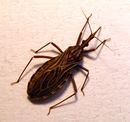PLoS Neglected Tropical Diseases (2016) 10 (4 - e0004527)
From Pestinfo-Wiki
 | Selected publication you are invited to contribute to the discussion section (above tab) |
Geological changes of the Americas and their influence on the diversification of the neotropical kissing bugs (Hemiptera: Reduviidae: Triatominae)
PLoS Neglected Tropical Diseases 10 (4 - e0004527)
Abstract:
Background
The family Reduviidae (Hemiptera: Heteroptera), or assassin bugs, is among the most diverse families of the true bugs, with more than 6,000 species. The subfamily Triatominae (kissing bugs) is noteworthy not simply because it is the only subfamily of the Reduviidae whose members feed on vertebrate blood but particularly because all 147 known members of the subfamily are potential Chagas disease vectors. Due to the epidemiological relevance of these species and the lack of an efficient treatment and vaccine for Chagas disease, it is more common to find evolutionary studies focusing on the most relevant vectors than it is to find studies aiming to understand the evolution of the group as a whole. We present the first comprehensive phylogenetic study aiming to understand the events that led to the diversification of the Triatominae.
Methodology/Principal Findings
We gathered the most diverse samples of Reduviidae and Triatominae (a total of 229 Reduviidae samples, including 70 Triatominae species) and reconstructed a robust dated phylogeny with several fossil (Reduviidae and Triatominae) calibrations. Based on this information, the possible role of geological events in several of the major cladogenetic events within Triatominae was tested for the first time. We were able to not only correlate the geological changes in the Neotropics with Triatominae evolution but also add to an old discussion: Triatominae monophyly vs. paraphyly.
Conclusions/Significance
We found that most of the diversification events observed within the Rhodniini and Triatomini tribes are closely linked to the climatic and geological changes caused by the Andean uplift in South America and that variations in sea levels in North America also played a role in the diversification of the species of Triatoma in that region.
(The abstract is excluded from the Creative Commons licence and has been copied with permission by the publisher.)
Full text of article
Research topic(s) for pests/diseases/weeds:
general biology - morphology - evolution
Pest and/or beneficial records:
| Beneficial | Pest/Disease/Weed | Crop/Product | Country | Quarant. |
|---|---|---|---|---|
| Rhodnius prolixus | ||||
| Triatoma infestans | ||||
| Triatoma sordida | ||||
| Rhodnius pallescens | ||||
| Triatoma brasiliensis | ||||
| Rhodnius pictipes | ||||
| Triatoma maculata | ||||
| Triatoma rubrovaria |